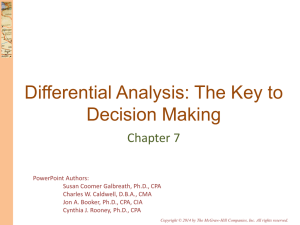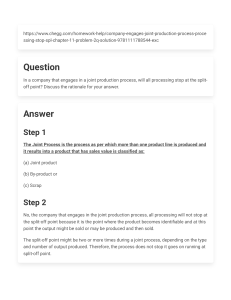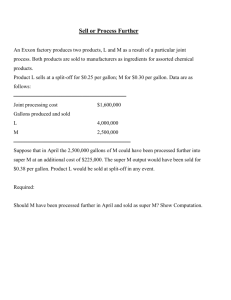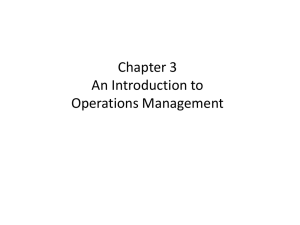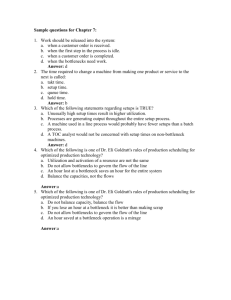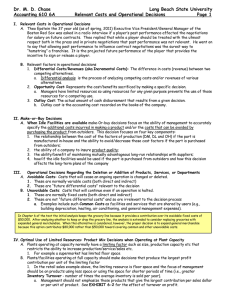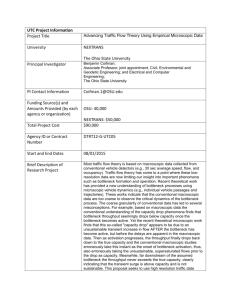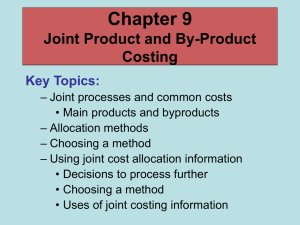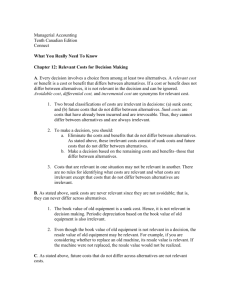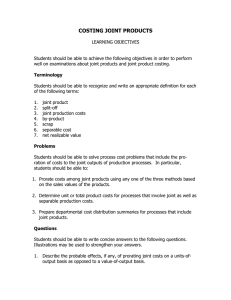Differential Analysis: Decision Making in Accounting
advertisement
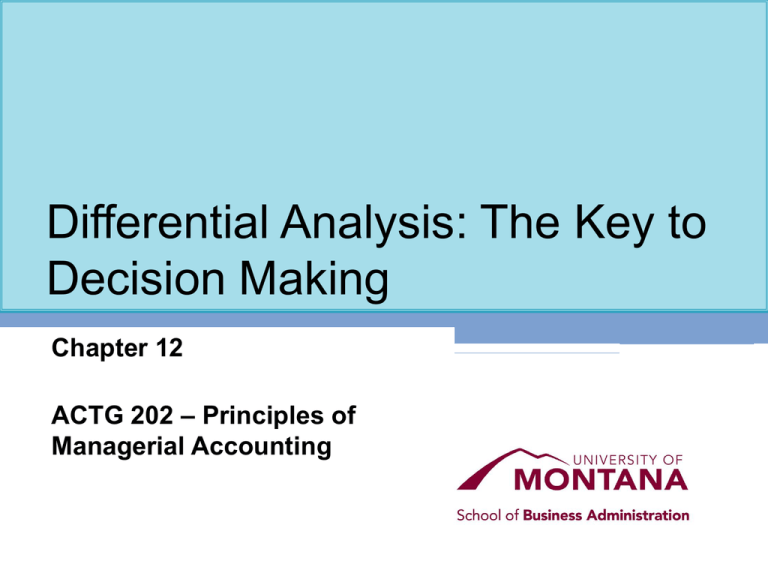
Differential Analysis: The Key to Decision Making Chapter 12 ACTG 202 – Principles of Managerial Accounting 12-2 Learning Objective 1 Identify relevant and irrelevant costs and benefits in a decision. 12-3 Relevant Costs and Benefits A relevant cost is a cost that differs between alternatives. A relevant benefit is a benefit that differs between alternatives. 12-4 Identifying Relevant Costs An avoidable cost is a cost that can be eliminated, in whole or in part, by choosing one alternative over another. Avoidable costs are relevant costs. Unavoidable costs are irrelevant costs. Two broad categories of costs are never relevant in any decision. They include: Sunk costs. A future cost that does not differ between the alternatives. 12-5 Decision Making: A Two-Step Process Step 1 Eliminate costs and benefits that do not differ between alternatives. Step 2 Use the remaining costs and benefits that differ between alternatives in making the decision. The costs that remain are the differential, or avoidable, costs. 12-6 Different Costs for Different Purposes Costs that are relevant in one decision situation may not be relevant in another context. Thus, in each decision situation, the manager must examine the data at hand and isolate the relevant costs. 12-7 Types of Decisions in this Chapter • Adding and Dropping Product Lines and Other Segments • The Make or Buy Decision • Special Orders • Utilization of a Constrained Resource • Joint Product Costs and the Contribution Approach 12-8 Learning Objective 2 Prepare an analysis showing whether a product line or other business segment should be added or dropped. 12-9 Adding/Dropping Segments One of the most important decisions managers make is whether to add or drop a business segment. Ultimately, a decision to drop an old segment or add a new one is going to hinge primarily on the impact the decision will have on net operating income. To assess this impact, it is necessary to carefully analyze the costs. 12-10 Beware of Allocated Fixed Costs Including unavoidable common fixed costs makes the product line appear to be unprofitable. Our allocations can make a segment look less profitable than it really is. 12-11 Learning Objective 3 Prepare a make or buy analysis. 12-12 The Make or Buy Decision When a company is involved in more than one activity in the entire value chain, it is vertically integrated. A decision to carry out one of the activities in the value chain internally, rather than to buy externally from a supplier is called a “make or buy” decision. 12-13 Vertical Integration- Advantages Smoother flow of parts and materials Better quality control Realize profits 12-14 Vertical Integration- Disadvantage Companies may fail to take advantage of suppliers who can create economies of scale advantage by pooling demand from numerous companies. While the economics of scale factor can be appealing, a company must be careful to retain control over activities that are essential to maintaining its competitive position. 12-15 Opportunity Cost An opportunity cost is the benefit that is foregone as a result of pursuing some course of action. Opportunity costs are not actual cash outlays and are not recorded in the formal accounts of an organization. 12-16 Learning Objective 4 Prepare an analysis showing whether a special order should be accepted. 12-17 Key Terms and Concepts A special order is a one-time order that is not considered part of the company’s normal ongoing business. When analyzing a special order, only the incremental costs and benefits are relevant. Since the existing fixed manufacturing overhead costs would not be affected by the order, they are not relevant. 12-18 Learning Objective 5 Determine the most profitable use of a constrained resource. 12-19 Key Terms and Concepts When a limited resource of some type restricts the company’s ability to satisfy demand, the company is said to have a constraint. The machine or process that is limiting overall output is called the bottleneck – it is the constraint. 12-20 Utilization of a Constrained Resource • Fixed costs are usually unaffected in these • • situations, so the product mix that maximizes the company’s total contribution margin should ordinarily be selected. A company should not necessarily promote those products that have the highest unit contribution margins. Rather, total contribution margin will be maximized by promoting those products or accepting those orders that provide the highest contribution margin in relation to the constraining resource. 12-21 Managing Constraints It is often possible for a manager to increase the capacity of a bottleneck, which is called relaxing (or elevating) the constraint, in numerous ways such as: 1. Working overtime on the bottleneck. 2. Subcontracting some of the processing that would be done at the bottleneck. 3. Investing in additional machines at the bottleneck. 4. Shifting workers from non-bottleneck processes to the bottleneck. 5. Focusing business process improvement efforts on the bottleneck. 6. Reducing defective units processed through the bottleneck. 12-22 Learning Objective 7 Prepare an analysis showing whether joint products should be sold at the split-off point or processed further. 12-23 Joint Costs • In some industries, a number of end products are produced from a single raw material input. • Two or more products produced from a common input are called joint products. • The point in the manufacturing process where each joint product can be recognized as a separate product is called the split-off point. 12-24 Joint Products – Petroleum Refining Example Joint costs are incurred up to the split-off point Joint Input Common Production Process Oil Gasoline Chemicals Split-Off Point Separate Processing Final Sale Final Sale Separate Processing Separate Product Costs Final Sale 12-25 Sell or Process Further Joint costs are irrelevant in decisions regarding what to do with a product from the split-off point forward. Therefore, these costs should not be allocated to end products for decision-making purposes. With respect to sell or process further decisions, it is profitable to continue processing a joint product after the split-off point so long as the incremental revenue from such processing exceeds the incremental processing costs incurred after the split-off point.
